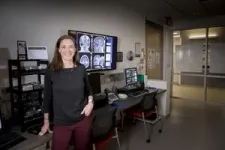(Press-News.org)
A University of Massachusetts Amherst sleep scientist, funded with $6.7 million in grants from the National Institutes of Health (NIH), has launched two unprecedented studies that will track over time the brain development of infants and preschoolers to confirm the role of napping in early life and to identify the bioregulatory mechanisms involved.
Rebecca Spencer, a professor of psychological and brain sciences who is well-known for her groundbreaking research into napping, is testing her theories about what’s happening in the hippocampus–the short-term memory area of the brain–as babies and young children undergo nap transitions.
This new research is expected to become the gold standard of scientific evidence that emphasizes the importance of healthy sleep for young children as their brains develop. The findings will help inform nap policies for preschool and pre-kindergarten and be useful to teachers and parents of both neurotypical and neurodiverse children.
“The work we’ve been doing has always pointed to this interaction of sleep and brain development,” says Spencer, who carries out research in her Somneurolab at UMass Amherst. “We think that kids get ready to transition out of naps when the brain is big enough to hold all the information of the day until night-time sleep.”
The study involving preschoolers is a collaboration between Spencer at UMass Amherst; Tracy Riggins, a developmental psychologist specializing in memory development at the University of Maryland; and Gregory Hancock, a UMD professor of human development and quantitative methodology. Previous research by Spencer and Riggins showed differences in the hippocampus of kids who nap compared to those who have transitioned out of naps.
“So far, we’ve used cross-sectional approaches,” says Spencer, referring to research that analyzes data at one point in time, as opposed to longitudinal studies that involve repeated observation over time. “We really need to show longitudinally within a child that the point when they transition out of naps is predicted by a transition in the development of their hippocampus.”
The hippocampus is the short-term location for memories before they move to the cortex for long-term storage. Naps allow children with an immature hippocampus to process memories. Young children give up their afternoon nap, not based on their age, but their brain development, Spencer hypothesizes. “Naps are beneficial to everybody. Naps protect memory for everybody, no matter what age. Kids who are habitual nappers really need the nap. If they don’t nap, they get catastrophic forgetting. That’s the difference between habitual and non-habitual nappers – not how good is the nap, but how bad is staying awake,” Spencer explains.
Adds Riggins, “In the end, being able to tell parents that those little deviations from routine that keep their children from napping might not have these huge implications for a neurotypical child in the long run would be great. And, the more we know about how the brain works in a typically developing child during this nap transition, the more we will be able to know about where we could possibly intervene to help neurodiverse children–like children with autism and ADHD, whose sleep patterns tend to be disrupted–since we will have some sort of scientific basis.”
The research team is recruiting 180 children, ages 3 to 5 years. The researchers will track their brain development, memory performance and nap status over the course of one year at three checkpoints. During the first and second sessions, the children will wear activity-tracking watches and EEG equipment to record naps and overnight sleep. They will also play memory games before and after naps. The children will undergo an MRI brain scan during the third session.
Monica and David Dumlao, of Chicopee, Mass., signed up their son Miles, 4, for the preschool study after watching the Netflix documentary series, “Babies,” which featured Spencer in the episode about sleep. “We like learning about the neuroscience behind brain development,” Monica Dumlao said at a recent study session in Spencer’s lab. “We thought this was a good opportunity to contribute to the science about the importance of naps.”
In the three-part infant study on nap transitions and memory, Spencer is studying the period before and after babies transition from two naps–one in the morning and one in the afternoon–to one, richer afternoon nap. She is recruiting 140 infants 7 to 9 months old. The babies will play a memory game before and after their naps. Their brain activity will be recorded during their naps using a noninvasive electrode cap. The sessions will take place at 9, 12 and 15 months.
“We think as they are getting ready to drop the morning nap, staying awake in that morning interval will be less and less damaging to their memory,” Spencer says. “But we don’t think that’s going to happen with the afternoon nap at this age. We think the afternoon nap stays superimportant.”
Parents interested in participating in the preschool sleep study are invited to fill out a screening form here; the screening form for the infant nap study is available here.
END
COLUMBUS, Ohio – New research points to an economic factor that might be overlooked when considering why drug-related deaths among Black Americans increased significantly after 2010 in U.S. regions reporting heightened fentanyl activity: job losses that followed the Great Recession.
Researchers analyzed data on employment, demographics, drug seizures and causes of death for over 200 counties in the United States between 2010 and 2021.
They found that overall, one more job per 100 Black workers in a county was associated with .29 fewer overdose deaths per 100,000 Black Americans – a substantial difference when considering that the latest drug mortality rate stands ...
DALLAS, April 25, 2024 — One school in each of the 32 National Football League (NFL) team hometowns has won a $1,000 grant for physical activity equipment as a part of the American Heart Association and the NFL’s NFL PLAY 60 Fitness Tracking Competition. The competition encouraged classrooms to get moving for at least 60 minutes every day and log their movement minutes through the NFL PLAY 60 app. Physical activity positively impacts overall mental and physical wellness which is essential to help children reach their full potential.
The number of winning schools corresponds to the number of NFL franchise teams while Rosholt High ...
Eggs and nesting baby birds exposed to moderate levels of anthropogenic traffic noise experience large, direct, and additive adverse effects on long-term development and fitness, according to a new study. The findings underscore the disruptive properties of noise on physiology, development, and reproduction, leading to lifelong fitness reduction, and call for a reassessment of the threat posed by anthropogenic noise and the need for noise mitigation measures. Noise pollution has become a global issue of concern, even in Earth’s ...
Dietary vitamin D modulates the gut microbiome to enhance the response to cancer immunotherapies, according to a new study in mice. The findings illuminate the poorly understood connection between vitamin D and immune responses to cancer via gut bacteria and suggest that vitamin D levels could serve as a potential determinant of cancer immunity and immunotherapy success. Vitamin D plays an important role in immune modulation as well as shaping the gut microbiome. Studies have also investigated the micronutrient’s role in cancer immunity as it’s been linked to both lower incidence of tumors and decreased mortality for several types of cancers and ...
A global meta-analysis of 186 studies reveals that conservation actions – particularly those targeted at species and ecosystems – yield significant positive impacts on biodiversity, according to a new study. Each year, billions of dollars are spent globally on conservation actions designed to halt and/or reverse the loss of biodiversity and degradation of ecosystems. Despite this, many international conservation goals, including those set by the Convention on Biological Diversity, remain unmet. While it could be concluded that current actions are insufficient or ineffective, researchers lack an understanding of how conservation actions ...
In a Policy Forum, Yann Robiou du Pont and colleagues argue that any method to derive company-level emissions targets inherently distorts competition in favor of existing companies and penalizes emerging or growing businesses. According to du Pont et al., despite their growing importance, companies’ emissions targets are not meaningful indicators to assess the ambition of their decarbonization plans and their alignment with the Paris Agreement. To meet international climate goals, it’s well understood that the ...
Francis Crick Institute press release
Under strict embargo: 19:00 BST Thursday 25 April 2024
Peer reviewed
Experimental study
Animals and people
Researchers at the Francis Crick Institute, the National Cancer Institute (NCI) of the U.S. National Institutes of Health (NIH) and Aalborg University in Denmark, have found that vitamin D encourages the growth of a type of gut bacteria in mice which improves immunity to cancer.
Reported today in Science, the researchers found that mice given a diet rich in vitamin D had better immune resistance to experimentally transplanted cancers and improved ...
Scientists have called for a concerted global effort to stem the tide of disposable electronic technologies – such as vapes – contributing to international waste accumulation and environmental degradation.
Writing in the journal Science, researchers from across the UK have highlighted how disposable vape sales quadrupled in the UK between 2022 and 2023, with consumers now throwing away around 5 million devices each week.
In the United States, 4.5 disposable vapes are thrown away each second, and it is fast becoming an issue replicated right across the world.
One of the main upshots, scientists say, is that vapes and other disposable ...
A new study published online today, April 25, in the scientific journal Science provides the strongest evidence to date that not only is nature conservation successful, but that scaling conservation interventions up would be transformational for halting and reversing biodiversity loss—a crisis that can lead to ecosystem collapses and a planet less able to support life—and reducing the effects of climate change.
The findings of this first-ever comprehensive meta-analysis of the impact of conservation action ...
For most human proteins, there are no small molecules known to bind them chemically (so called “ligands”). Ligands frequently represent important starting points for drug development but this knowledge gap critically hampers the development of novel medicines. Researchers at CeMM, in a collaboration with Pfizer, have now leveraged and scaled a method to measure the binding activity of hundreds of small molecules against thousands of human proteins. This large-scale study revealed tens of thousands of ligand-protein interactions that can now be explored for the development of chemical tools and therapeutics. Moreover, ...



